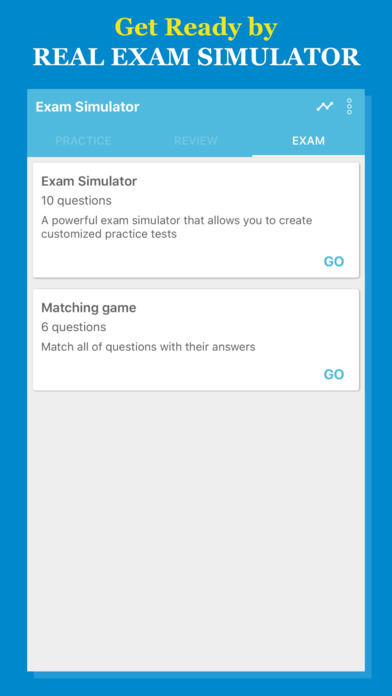
THE #1 SELLING STUDY APP NOW HAS THE MOST CURRENT EXAM QUESTIONS. PASS YOUR EXAM AT THE FIRST ATTEMPT BY STUDYING ANYWHERE, ANYTIME WITHOUT THE INTERNET CONNECTION.
Before you buy another app, ask yourself:
- Does it Offer REAL EXAM questions and terminology? WE DO!
- Does it Break learning materials into small sets of questions to enhance your learning capability? WE DO!
- Does it Help you master each question effortlessly by various methods: flash cards, matching game, true/false, M/C, etc? WE DO!
- Does it Detect & separate the most difficult questions automatically? WE DO!
- Does it Track your learning process on every set and exam taken? WE DO!
- Does it Let you experience the REAL EXAM Simulator? WE DO!
Premium Upgrade:
+) Lifetime access to all Practice Tests.
+) Lifetime access to the EXAM SIMULATOR.
+) Track all hardest and weakest questions automatically.
+) Track history on every exam taken and practice progress.
+) Lifetime support & updates when NEW learning material available.
Free with download:
+) Hundreds of practice questions & terms
+) Free Exam Builder
+) Free Matching Game
+) Filter hardest and weakest questions
The American Board of Applied Toxicology (ABAT) examination tests for knowledge of applied toxicology and the ability to use that knowledge to solve problems with patients. ABAT certification does not provide licensure, but toxicologists who pass the examination have the distinction of being diplomates of the American Board of Applied Toxicology (DABAT). Some common uses of applied toxicology certification include practicing in or directing a poison control center, working with health care professionals and medical examiners to treat patients and assisting in forensic examinations. The exam is written and administered by ABAT. The organization was founded in 1985 by the American Academy of Clinical Toxicology to provide a special focus on the field of applied clinical toxicology and those professionals working in the field.
The test features two major components: a section of short answers and a problem-solving section. Test takers have five and a half hours to complete the exam.
The examination is administered in two sections over two days. It includes one section of short answers and a problem-solving section. The examination is given on paper. Pencils and all other necessary items will be supplied at the testing site.
The short-answer section is comprised of 125 questions:
Drugs: 40 questions
Chemicals: 35 questions
Environmental/Occupational: 15 questions
Toxicology Theory: 10 questions
Biologicals: 15 questions
General: 10 questions
The short-answer section tests one’s ability to recall general facts, but, more importantly, asks candidates to apply this knowledge to clinical decisions.
The problem-solving section is comprised of three clinically-oriented problems and one problem devoted to literature review, research and/or giving expert testimony.
The clinically-oriented problems test the candidate’s ability to assess a patient’s condition and work through the problem. The second type of problem-solving question tests the candidate’s ability to provide expert testimony, conduct research and review relevant literature
Disclaimer:
This application is just an excellent tool for self-study and exam preparation. Its not affiliated with or endorsed by any testing organization, certificate, test name or trademark.



